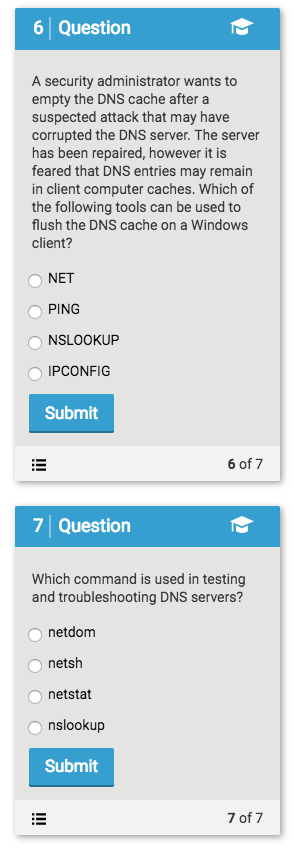Answered step by step
Verified Expert Solution
Question
1 Approved Answer
4 Question Both DNS poisoning and ARP poisoning involves: O Distributed DoS O DoS O Spoofing O Replaying O Eavedropping Submit 5 Question M


4 Question Both DNS poisoning and ARP poisoning involves: O Distributed DoS O DoS O Spoofing O Replaying O Eavedropping Submit 5 Question M 4 of 7 Which of the following statements are true about client-side DNS? (Choose all that apply). Client-side DNS should be configured to point towards the DNS server that is authoritative for the domain that client wants to join The Root Hints file has the IP addresses of the 13 root DNS servers If a web site can be reached by IP address and not by host name, then DNS or the Hosts file would be the problem. The cache.dns file has the IP addresses of the 13 root DNS servers Check out DNS settings using the NSLookup command If an APIPA address is assigned, then DNS is the problem Submit Check out DNS settings using the DIG command 5 of 7 6 Question A security administrator wants to empty the DNS cache after a suspected attack that may have corrupted the DNS server. The server has been repaired, however it is feared that DNS entries may remain in client computer caches. Which of the following tools can be used to flush the DNS cache on a Windows client? NET PING NSLOOKUP IPCONFIG Submit 7 Question 6 of 7 Which command is used in testing and troubleshooting DNS servers? netdom netsh netstat nslookup Submit 7 of 7
Step by Step Solution
There are 3 Steps involved in it
Step: 1
4 Both DNS poisoning and ARP poisoning involve spoofing which is the act of impersonating another device or network in order to gain unauthorized access or manipulate network communication Spoofing is ...
Get Instant Access to Expert-Tailored Solutions
See step-by-step solutions with expert insights and AI powered tools for academic success
Step: 2

Step: 3

Ace Your Homework with AI
Get the answers you need in no time with our AI-driven, step-by-step assistance
Get Started


